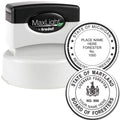You might think “quality assurance stamps” are just small marks of approval, but they actually carry a lot of weight in any inspection or certification process. They keep your operations consistent, build trust with clients, and help organize daily workflows. By choosing the right stamp, you can avoid confusion and ensure your products or documents look tidy and professional.
Below, you’ll find a friendly guide that walks you through everything you need to know about ordering, using, and maintaining QA stamps. From design options to supplier tips, let’s explore how to get a stamp you’ll happily rely on for years.
Know The Basics Of QA Stamps
What Quality Assurance Stamps Mean
Before diving deeper, it helps to understand what these stamps represent. A QA or QC stamp typically includes key details such as date, inspector ID, and a phrase or symbol indicating successful inspection. Using these stamps often signals a final check has been completed.
You can apply stamps on product labels, shipping materials, or even documents that require an official approval. By placing that small but visible mark, you confirm that specific safety or procedural standards have been met. It also lets everyone see, at a glance, the status of any item or batch.
Why Stamps Streamline Communication
Imagine you receive dozens of parts or papers every day. You don’t have time to read through lengthy reports each time, right? Stamps provide a simple, direct method to communicate “passed,” “failed,” or any other quick status update. In busy workplaces, this clarity goes a long way toward preventing mix-ups.
Stamps are also more cost-effective than printing large labels or relying solely on handwritten notes. Unlike a pen, a well-inked stamp guarantees consistency in placement, legibility, and overall look. That uniformity can help your business present a professional front, especially if clients or regulators ever come auditing.
Consider Your Types And Designs
Stock vs. Custom Options
One of the first decisions you’ll face is whether to get a stock stamp or a custom one. Stock stamps typically have a fixed design, like “APPROVED,” “REJECTED,” or “INSPECTED.” They’re affordable and easy to order right out of the box. However, if you need something more detailed, you might prefer a custom inspection stamp.
A custom design can include your company’s name, logo, or a specific message you want to convey. This route lets you fine-tune everything, from text size to the shape of the border. Keep in mind that more complex designs may take a bit longer to produce.
Adding Your Branding Elements
Any chance to reinforce your brand identity is valuable. Maybe you want your logo on your stamp or a tagline that sets you apart from your competitors. If that sounds appealing, check out the company logo inspection stamp for a simple way to incorporate your unique branding. Having your logo inside the stamp can be a quick conversation starter when clients see your process of approving goods or documents.
Choosing Ink Colors
Sure, a classic black or blue stamp ink gets the job done. But have you considered stepping outside the norm with red, green, or other vibrant colors? Different colors can help employees spot crucial notices faster. For example, you might assign green to “approved,” red to “rejected,” and purple to “needs re-check.” If you handle multiple product lines, color-coding can keep everything tidy and streamlined.
Compare Different Materials
Self-Inking vs. Pre-Inked
If you’ve browsed quality assurance stamps online, you’ve probably spotted two main categories: self-inking stamps and pre-inked stamps.
- Self-inking: Comes with a built-in ink pad plus rotating mechanism. After each impression, the text plate re-inks on the pad, so you don’t have to manually ink it each time.
- Pre-inked: The ink is infused directly into the stamp’s text plate. This produces crisp impressions and tends to last longer before needing a refill, but they can cost a bit more upfront.
Pick the style that best suits your expected stamping volume. If you’re stamping hundreds of times a day, a self-inking model might be more cost-effective. Meanwhile, pre-inked stamps can deliver sharper results if you’re going for a high-quality appearance on documents or packaging.
Rubber vs. Polymer
You’ll commonly see stamp text plates made of rubber or a polymer material. Rubber is the traditional choice. It’s tough and can handle most standard ink types. Polymer technology, though, has come a long way in recent years. It’s more modern, can handle finer detail, and often yields a precise impression—perfect if your design has tiny text or your brand logo includes intricate lines.
In either case, it’s wise to invest in a durable handle or body so you don’t replace hardware every few months.
Partner With A Trusted Supplier
Why Supplier Reputation Matters
You don’t want to gamble on quality assurance stamps, especially if you’ll use them daily. A reliable supplier ensures each stamp is made to last, from the text plate to the ink refill system. They’ll also be more likely to work with you on custom designs and deliver them without excessive delays.
Introducing ESS And What We Provide
When you’re shopping around, consider reaching out to ESS. We’ve been family owned and operated since 1964, providing top-notch custom stamps, QA stamps, QC stamps, and inspection stamps. We believe in going the extra mile for our customers, offering excellent customer service and surprisingly quick turnaround times. From the moment you share your design idea to the day your stamps arrive at your doorstep, you’ll get personalized attention and expert guidance.
Many businesses find that personal touch extremely helpful. After all, your stamp design speaks volumes about your brand. You want to be sure it’s handled by folks who’ve been at this for a long time and truly know how to deliver a great result.
Getting A Quote
Ordering a custom design might sound daunting, but it’s simpler than you might think. Usually, you can just send over your desired text or artwork. Then, the supplier—especially one like ESS—will confirm the layout and provide a final proof. You’ll get a chance to review everything, request changes, and give your final thumbs-up before production even starts.
Once the design is approved, your supplier can give you an estimated turnaround time. If you have a tight schedule, be sure to mention that upfront so they can do their best to meet your deadline.
Use And Maintenance Tips
Proper Technique For Crisp Impressions
Sometimes it’s tempting to just stamp away in a hurry. But here’s a tip: apply gentle, even pressure to the surface. Slamming the stamp down or rocking it side to side can lead to smudges or uneven lines.
If you’re new to stamping or using a design that’s especially detailed, you may want to test your stamp on a scrap piece of paper first. This little practice session helps you gauge the right amount of pressure and see if the ink is properly distributed.
Cleaning And Re-Inking
To keep your impressions looking sharp, adopt a regular cleaning routine. Ink residue can build up on the text plate after repeated use, which might lead to blurry prints. A quick wipe with a damp cloth is often enough to remove excess residue. Just be careful not to soak the stamp, or you risk damaging it.
Eventually, the ink supply will run low. Re-inking instructions depend on whether you have a self-inking or pre-inked stamp. Most self-inking stamps have an accessible ink pad you can remove and refill. Pre-inked stamps usually need specialized ink applied directly to the text plate or the reservoir. Follow the instructions that come with your stamp, and you should be good to go.
Simple Storage Solutions
It’s easy to forget about storage, but it can play a bigger role than you might expect. If your stamp sits exposed in a dusty or humid environment, the text plate can deteriorate faster or the pad might dry up. Stash your stamp in a small drawer or a dedicated container when you’re not using it. That small step helps protect your investment and lengthens your stamp’s lifespan.
Wrap It Up
Shopping for a quality assurance stamp is all about understanding your specific needs. Do you require a basic “APPROVED” stamp, or do you want a more detailed design with a company logo and inspector ID? Are you aiming for a self-inking solution or pre-inked crispness? Once you have a firm grip on those details, partnering with a reputable supplier like ESS makes the process seamless.
Ultimately, your stamp is an extension of your brand’s commitment to delivering consistent quality. It’s amazing how one small mark can convey professionalism, attention to detail, and trustworthiness to everyone who sees it. When you invest in a stamp you’ll love, you’re setting up a straightforward, time-saving system that supports your quality assurance goals for years to come.
Frequently Asked Questions
How Do I Choose The Right Ink Color?
It depends on your specific workflow needs. If you just want legibility, black or blue works well. For quicker identification of different statuses, consider color-coding (green for approved, red for rejected). Pick what makes your process easiest.Can I Add My Company Logo To A Stamp?
Absolutely. Many businesses create custom inspection stamps by adding their logo and other details. If you want a quick solution, check the company logo inspection stamp page for options that showcase your branding.What If I Need A Large Volume Of Stamps Fast?
It’s best to communicate your timeline upfront. At ESS, we specialize in fast turnaround times without compromising quality, so you’ll likely get your stamps within your required window. Our decades of experience make it easy to scale up production quickly.Are Pre-Inked Stamps Really Worth The Extra Cost?
They can be, especially if you require highly detailed impressions. Pre-inked stamps often produce cleaner results and last longer before needing a refill. That might offset the initial extra expense in the long run.How Long Do These Stamps Typically Last?
With proper care, your QA or QC stamp can last for years. Regular cleaning and proper storage go a long way. If you keep it free from dust and refill ink promptly, you’ll maintain consistent, clear impressions for a very long time.
Feel free to reach out if you have more questions. You now have a clear roadmap for choosing and caring for quality assurance stamps. A good stamp is a small tool that can make a big difference in your day-to-day workflow, so take a moment to find the right fit. Happy stamping!


















